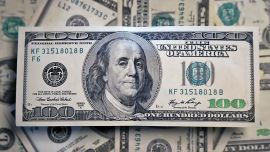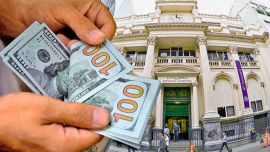Javier Milei, Argentina's libertarian lawmaker who will assume office as president on December 10, imagines a country where the official currency is the US dollar and there is no Central Bank.
The far-right outsider is hoping to reign in inflation that has hit 140 percent, bedeviling the country as it struggles with a deep economic crisis.
Several Latin American countries have already officially or unofficially dollarised their economies, some in order to solve hyperinflation, or just about, in all cases hoping to usher in new eras of economic and financial stability that could not be achieved using their own currencies.
The following are a few examples of dollarisation in the region, along with how and why these countries made the switch to the US greenback.
Ecuador
Ecuador adopted the dollar in March 2000, hoping to shake off a profound banking crisis that had caused US$5 billion in losses and left thousands of people broke. The ensuing price increases threatened to accelerate into runaway hyperinflation.
The transition from the sucre to the dollar came after a bank holiday coupled with a temporary freeze to half of all deposits – emergency steps that seemed to work.
Inflation levels came down rapidly, with Ecuador sometimes even veering into periods of deflation. The country's 2023 annual inflation rate is expected to sit at 3.1 percent.
El Salvador
El Salvador dollarised on January 1, 2001. The government of then-president Francisco Flores (1999-2004) argued that it sought to make the country more attractive to foreign investment and trade, and also to reduce the risk of devaluation and to enable the banking system to be able to provide better credit offers.
“Dollarisation has had its adverse effects. It has increased the cost of living. When the dollar came in, the prices of goods and services soared and the poorest are still worse off. We don’t have a monetary policy, as we depend on what the United States does with the currency,” independent economist César Villalona remarked.
In 2021, El Salvador also made bitcoin an official currency, part of the campaign platform of President Nayib Bukele.
The country's annual inflation reached 7.32 percent in 2022, but is predicted to come down to 3.3 percent for 2023.
Panama
The dollar has circulated as the official currency of Panama for longer than any other Latin American country, alongside the local balboa.
The greenback has been used since 1904, shortly after the country became independent from Colombia and moved closer to the United States with the construction of the Panama Canal, which only reverted to Panamanian control in 1999.
For the balboa, only coins are minted and no notes are printed, the public sector only uses the currency for accounting purposes.
Panama has annual inflation levels under three percent.
Venezuela: de-facto dollarisation
The dollarisation process in Venezuela has been more informal.
Venezuela has had informal dollarisation since late 2018, when the government relaxed stringent foreign exchange controls as an escape valve to the acute crisis. By then the country was going through its first year of hyperinflation, with a shortage of local currency, the bolivar.
"A set of general factors had to do with the de facto dollarisation. Structurally, it was high inflation, but there were also other driving factors such as the electricity crisis”, recalled Albusdata economic analyst Henkel García.
Without power, card payment points stopped working, and given the shortage of bolivars in cash, the dollar was the natural alternative.
The plunge in the value of the bolivar made great volumes of cash necessary to pay for goods and services.
The country finally escaped hyperinflation in 2022, though it still faces one of the highest inflation rates in the world. Until September, Venezuela's annual inflation rate was 317 percent, according to its central bank.
Ironically, the greenback – a symbol of “American imperialism” and considered an “enemy of the revolution” – has become the currency with the “greatest circulation,” according to economists.
Dual-currency economies
In some Latin American countries such as Peru and Uruguay, the dollar is used to pay for certain consumer goods and services – like rent, real estate, vehicles and household – and US bills can be withdrawn from ATMs and used to open bank accounts, even though the official currency for government affairs remains fixed in local money.



















Comments